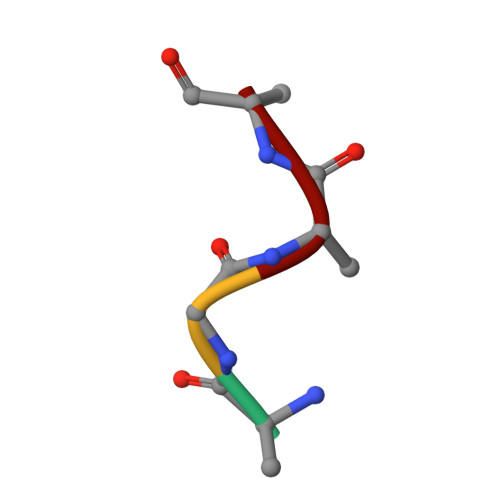From nonpeptide toward noncarbon protease inhibitors: Metallacarboranes as specific and potent inhibitors of HIV protease
Cigler, P., Kozisek, M., Rezacova, P., Brynda, J., Otwinowski, Z., Pokorna, J., Plesek, J., Gruner, B., Doleckova-Maresova, L., Masa, M., Sedlacek, J., Bodem, J., Kraeusslich, H.-G., Kral, V., Konvalinka, J.(2005) Proc Natl Acad Sci U S A 102: 15394-15399
- PubMed: 16227435
- DOI: https://doi.org/10.1073/pnas.0507577102
- Primary Citation of Related Structures:
1ZTZ - PubMed Abstract:
HIV protease (PR) represents a prime target for rational drug design, and protease inhibitors (PI) are powerful antiviral drugs. Most of the current PIs are pseudopeptide compounds with limited bioavailability and stability, and their use is compromised by high costs, side effects, and development of resistant strains. In our search for novel PI structures, we have identified a group of inorganic compounds, icosahedral metallacarboranes, as candidates for a novel class of nonpeptidic PIs. Here, we report the potent, specific, and selective competitive inhibition of HIV PR by substituted metallacarboranes. The most active compound, sodium hydrogen butylimino bis-8,8-[5-(3-oxa-pentoxy)-3-cobalt bis(1,2-dicarbollide)]di-ate, exhibited a K(i) value of 2.2 nM and a submicromolar EC(50) in antiviral tests, showed no toxicity in tissue culture, weakly inhibited human cathepsin D and pepsin, and was inactive against trypsin, papain, and amylase. The structure of the parent cobalt bis(1,2-dicarbollide) in complex with HIV PR was determined at 2.15 A resolution by protein crystallography and represents the first carborane-protein complex structure determined. It shows the following mode of PR inhibition: two molecules of the parent compound bind to the hydrophobic pockets in the flap-proximal region of the S3 and S3' subsites of PR. We suggest, therefore, that these compounds block flap closure in addition to filling the corresponding binding pockets as conventional PIs. This type of binding and inhibition, chemical and biological stability, low toxicity, and the possibility to introduce various modifications make boron clusters attractive pharmacophores for potent and specific enzyme inhibition.
Organizational Affiliation:
Institutes of Organic Chemistry and Biochemistry and Molecular Genetics, Academy of Sciences of the Czech Republic, Flemingovo námestí 2, 166 10 Prague 6, Czech Republic.
















